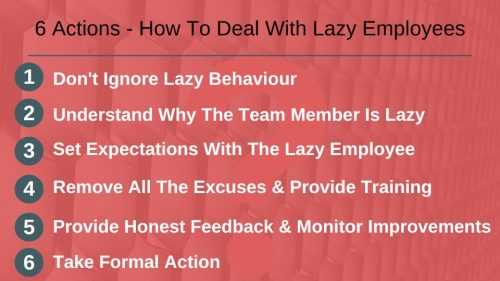How to Manage Lazy Team Members – 6 Ways to Deal with Lazy Employees

Working out how to manage lazy team members and taking the right action to reduce or remove the issue is a challenge most managers’ dread. I certainly never enjoyed it, yet I knew that taking no action was by far the worst option.
If you ignore the problem, laziness has a way of spreading into the rest of the team. Take action quickly.
I am taking you through 6 actions to take for how to deal with lazy employees.
There can be lots of reasons why employees become or are lazy and without finding out more, taking the right action is really tough
How to Manage Lazy Team Members – 6 Ways to Deal with Lazy Employees
- Don’t ignore lazy behaviour
- Understand why the team member is lazy
- Set expectations with the lazy employee
- Remove all the excuses & provide training
- Provide honest feedback and monitor for improvement
- Take formal action if the lazy behaviour continues
Watch on YouTube
Listen on Podcast
Don’t Ignore Lazy Behaviour – The first action for how to manage lazy team members
By ignoring lazy team members, you are effectively signalling through your actions – to the individual and the whole team – that it is okay to be lazy at work. The unintended message you are sending is that I won’t deal with a lazy employee so be as lazy as you like. The lazy employee will continue being lazy and may well get even worse.
The rest of the team know the team member is being lazy and see you not taking action to tackle the lazy team member. This leaves the team with no incentive to work hard. The productivity of the team starts dropping. Your effectiveness as a manager will be called into question. Don’t let a downward spiral start – take action.
Also, your annoyance, anger and stress levels are going to rise the longer you put off dealing with the lazy employee. As a manager you must deal with the lazy team member. The quicker you take action to manage the lazy employee, the easier it is to improve their work ethic and the less problems you will have to deal with in the rest of the team.
Take action quickly to tackle a lazy staff member.
Understand Why The Team Member Is Lazy – The second action to manage lazy team members
Book a private meeting room and talk to the lazy employee. Set out the issues you are having with their performance, the reasons why their laziness is an issue for you, the team or business and provide specific examples. Go through the impact on you, the team and the business. Do not talk in general terms, be specific and use examples.
Give them a chance to respond.
Remember, there can be a big difference between a previously hard working team member who has become lazy compared to an employee that always seems to be lazy.
If the employee’s motivation has changed, find out why they have become lazy. Until you speak to them and ask them you will only be guessing. Be supportive, care and most important – actively listen to what they say. Ask what the problem is and then stop talking. It is harder than it sounds – particularly if the silence stretches into two or three minutes.
When you know what the problems are, then you are in a much better place to help that individual.
Some common reasons for employees being lazy include:
- Lacking direction or understanding of what is expected of them
- They don’t feel they are able to do what is being asked of them – e.g. potentially a lack of training
- They lack feedback to know what is going well or not and have become disheartened
- They might be really bored in their role or lack goals that stretch them
- They might have personal issues outside work
- They may have physical or mental health issues
- They may be upset or angry about decisions made or actions taken by you or others at work
- There may be unresolved conflict with other team members
And there are plenty of other reasons. Speak to the individual about their behaviour and lack of motivation. Be specific and use examples of their behaviour and then actively listen to their response.
Find out why they have become lazy or why they are being lazy.

Set expectations with the lazy employee – The third action
Tell the lazy team member what you think and set out what you want them to change i.e. set out your expectations. Ask the lazy employee for feedback and input into the expectations.
Getting their input and compromising takes more time than just setting out your expectations. The benefit you get is the other person has inputted into the expectations, been listened to and you have compromised – all of which means they are a lot more likely to agree with and own the expectations and thus be more motivated to achieve them.
Next set measurable goals together.
Once you have agreed the goals to be reached or what good looks like, discuss how they are going to get from where they are now to meeting and beating those goals. Get the lazy employee to provide input and ideas as to how to they are going to improve their attitude, motivation, and behaviour. Find out what help they need.
With lazy employees, I suggest you agree an acceptable levels of output from activities and projects that they are working on. Use other team members output as a benchmark if possible.
Create a timeframe for the lazy staff member to reach the level of outputs agreed. Timeframes could range from 1 week for simple tasks to a couple of months – it really depends on what is being worked on.
Create and communicate clear measurable expectations
Remove all the excuses & provide training – The fourth action to manage lazy team members
Most lazy employees that I have dealt with provide a long list of excuses as to why they are not able to deliver as much as their colleagues.
Note down the excuses that they provide. Some you may be able to challenge on the spot, others you should take away and do some homework. Don’t pit your opinion against theirs. Pit evidence against their opinion which is a lot harder to argue against.
Do your homework and then come back to the lazy employee. For all the spurious excuses, demonstrate that these are not real factors – say by comparing output to their colleagues’ output who use the same resources and training.
Lack of training is usually one of the excuses most lazy employees use. Review what training has been given. Some people don’t learn quickly, so a training refresher may well help if practical to give. If they have not previously received training, provide it.
Work to counter and remove all the spurious excuses. Follow up with your arguments and evidence in writing to the lazy individual.
With genuine issues, work out how you are going to help the individual overcome that issue. It is in your interests to ensure you do your best to support the lazy employee. Putting in a bit of time and resources to increase the output from a lazy staff member is cheaper, quicker and less hassle than finding a new employee.
Put in the effort to remove all the spurious excuses the lazy employee has and fill any genuine gaps in skills, resources, and knowledge that they may have.

Provide honest feedback and monitor for improvement – The fifth action for how to manage lazy team members
I recommend that you provide lots of open and honest feedback to the lazy employee. Without specific feedback, they are not going to know where they are falling down and what expectations they are meeting. Leaving them guessing is not fair to them and it does not help improve their performance.
When giving feedback, do your best to make it
- Open and honest
- The feedback is a specific and detailed as possible. Use lots of examples.
- Give feedback with their development in mind
- Don’t delay giving feedback – you want them to improve as quickly as possible.
As a manager, it is vital that you monitor progress and measure the performance improvement in some way. Then you can discuss facts and data with the lazy team member rather than just your opinion against their opinion. Facts and data are much less subjective and a lot fairer, plus it is clear how much individual has improved or not.
Some example ideas of measurement include:
- Tracking Sales generated against targets
- Cost savings gained against targets
- Activities performed in an improved timeframe or quality level
- Projects completed to agreed parameters
- Scored feedback from colleagues, customers, or suppliers
When relying on opinion, try to gather several opinions rather than just putting forward your own. This adds more weight to the feedback and is fairer.
Give honest useful feedback. Be as specific as possible. Feedback on what is going well and what is not and use data to provide a factual progress assessment where possible.

Take formal action – The sixth action to manage lazy team members
If you are seeing no signs of improvement or not enough improvement, then take more formal action to deal with the lazy employee.
I would recommend moving the lazy team member onto a Personal Improvement Plan, which sets out clear expectations in a written document, with suggestions of how to achieve those expectations or goals and how you are going to monitor progress. Using a Personal Improvement Plan moves your actions onto a more formal setting. Involve HR to increase the pressure on the lazy team member to change if needed.
The work you put in to agree and document the plan and your monitoring of progress or lack of it can be used as part of a disciplinary process, which would be the final step you turn to.
It is painful to remove someone from the business – for them, for you, your team, and the business. If the person is not helping the team or not happy, they are likely to be better off in a different job and different environment. Make the difficult choices and take action.
Moving a lazy employee who doesn’t want to work harder to another team or department may seem like an easier option, but it will not be easier for the business overall. The problem will remain and someone else will have to deal with it. Passing the buck is likely to come back to haunt you when your managers are talking about who to promote and which manager to give more staff to. So work out how to deal with a lazy team member and take action to resolve the problems one way or the other.
In Summary
Please use the 6 actions outlined for how to manage lazy team members. It is really important for everyone that you take action quickly when you spot lazy behaviour. This will help the lazy team member, you, your team, and the business.
The actions we have been through include

If you let one team member be obviously lazy, it won’t be long before half the team joins in. This is good for you or anyone else in the long run.
Take action in a fair and reasonable way.
Lazy team members can wreck your team’s momentum and cause a lot of ill feeling amongst the team. As a manager, I think it is really important that you don’t accept lazy behaviour. You owe it to all the team members that work hard and deliver a lot for the team.
Pulling up lazy team members is not about being a tyrant or an overly demanding manager. Ask your team members to pull their weight and support everyone else in the team by doing so.
Some of the time a quiet word is enough. Other times, a more progressive and formal approach is needed. Take proactive action in a fair and sensible way to make sure lazy team members know that lazy behaviour is not okay.






